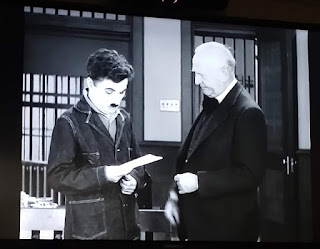Unveiling the Zeitgeist: Charlie Chaplin's Cinematic Reflections on the 20th Century
This blog is prepared as the thinking activity task. I'll be preparing the other blog also and in this blog I'll discuss about the 20th century film of Charlie Chaplin ' Modern Times ' in 1936, which talks about the major characteristics of the 20th century.
Overview of the Modern Times:
Modern Times" is a 1936 film of Charlie Chaplin. It's a silent comedy that critiques industrialization and its impact on society. Chaplin's character was vagrant who struggles with the dehumanizing effects of mechanization. The Tramp was usually the victim of circumstances and coincidences, but sometimes the results work in his favour. In Modern Times, he picks up a red flag that falls off a truck and starts to wave it at the truck in an attempt to return it, and by doing so, unknowingly and accidentally becomes the leader of the protesting group of workers, and ends up in jail because of it. The film is a blend of humor and social commentary on the challenges of the modern era.
Frame Study:
Frame study analysis how people translate information by surveying to build understanding of events or matters. It explores the framing of ideas in conveying and shaping individuals conception of reality through dialect, sign and conditions, influencing Frame of mind and activity.
Motorization of humans in the context of industrialization:
The watch is used as a central motif, this frame contains the movie's storyline, themes, and character essence. It symbolizes how individuals are confined by time, depicting the repetitive nature of industrial life and highlighting their metaphorical enslavement to the clock—a potent image echoing the mechanical, industrialized essence of the 20th century.
Chaplin's 'Modern Times' eloquently captures the dehumanizing impact of industrialization. The relentless machinery symbolizes the mechanization of human beings, stripping away individuality in the pursuit of efficiency. The assembly line, a hallmark of industrial progress, becomes a metaphor for the erosion of craftsmanship, highlighting the harsh realities of mass production overshadowing the artistry of human labor.
This frame portrays where workers perform repetitive tasks, stuck in a monotonous routine. The workers are so engrossed in their work that they can't even stop to remove a bee from their colleague's face. It shows how the workers are bound by their work, unable to break away from the tedious cycle. The scene emphasizes the dehumanizing nature of such work, where individuals are trapped in a mechanical rhythm, losing touch with their surroundings and even their own instincts or reactions.
Rich-Poor Divide and Capitalist Promises:Struggles for Basic Amenities and Human Rights:
Chaplin's lens extends beyond borders, capturing the universal struggle for basic amenities amid the growing richness of nations. Whether it's the fight for food, shelter, or clothing, his films resonate with the challenges faced by individuals in a rapidly changing world. 'Modern Times' becomes a mirror reflecting the hardships of everyday life, transcending temporal boundaries.
Charlie Chaplin's cinematic masterpieces serve as more than mere entertainment; they are profound reflections on the zeitgeist of the first fifty years of the 20th century. Through his lens, we witness the echoes of industrialization, the stark realities of the rich-poor divide, the menace of dictatorial regimes, and the timeless struggles for basic human rights. As we delve into these cinematic gems, we not only understand the past but also find poignant lessons for navigating the complexities of the present.
Below there's a video of the film which would help you to understand the frames more precisely.
Happy learning🌻
















No comments:
Post a Comment